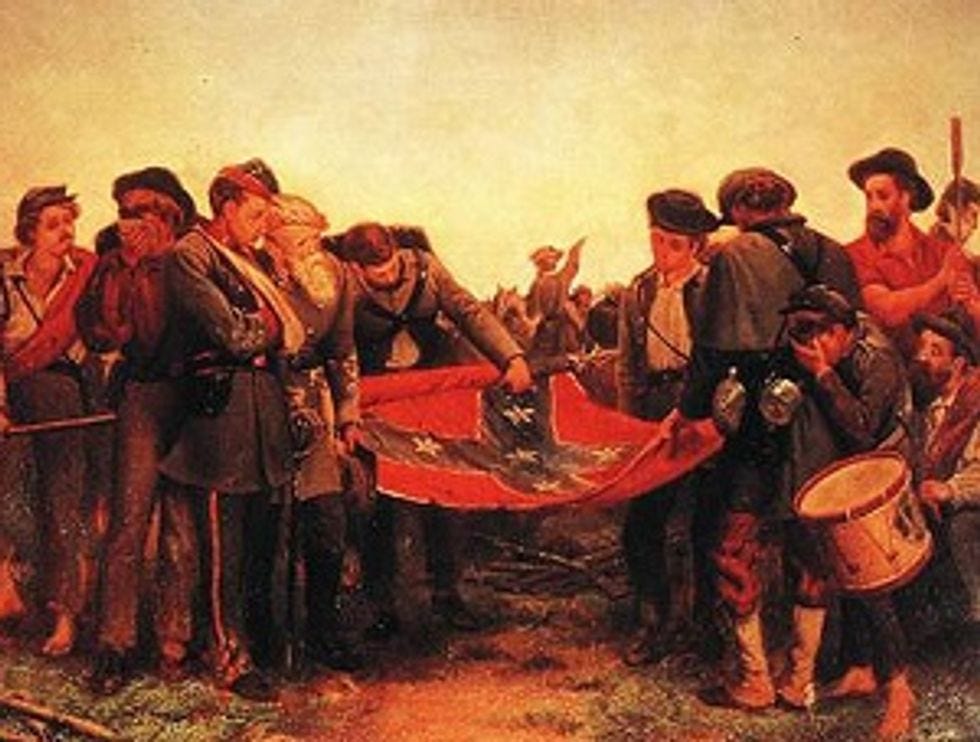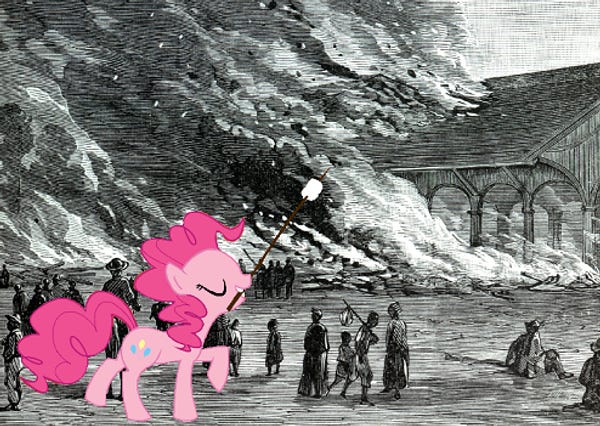Sundays With The Christianists: American History Textbooks For Homeschoolers Marching Through Georgia
We didn't really intend to spend three weeks on the topic of our Christian textbooks' coverage of the Civil War. Then again, both the North and South expected the war itself to take only a few months. With all the current talk of a "short, limited air campaign" against Syria, we wonder if maybe there's a useful metaphor in that? And maybe, while we're at it, in Mark Twain's "The War Prayer"? Hahaha, who do we think we are kidding?
In any case, let's start with the really important question about the Civil War: How did it help Americans come to Jesus Christ? Our 8th-grade text from A Beka, America: Land I Love, answers this question with a short section on "Revival and Christian Charity," where we learn that
Many Christian revivals swept across the Confederate camps as soldiers realized their need to rededicate themselves to God or repent and be saved before a battle.
More important, we learn that that Christians make good leaders!
Surely, the strong Christian leadership of General Lee and General Jackson had much to do with this godly movement. General Jackson shared his Christian testimony with his men. Before the war, he taught a Sunday school class for black slaves, and during the war he continued to send money for the support of the Sunday school class. On the battlefield, Jackson was known for his emphasis on Christian behavior among his troops.
Wasn't he a sweetheart? Meanwhile, in the North, we learn that
volunteers from The United States Christian Commission provided food, clothing, medicine, nursing care, and spiritual comfort to soldiers in every major Union camp. They distributed millions of salvation tracts and thousands of Bibles to the soldiers and provided a free mail service to help the men keep in touch with their families back home. When some soldiers claimed that they drank whiskey because there was no hot coffee in their camps, the Christian Commission established free coffee wagons.
In other words, men in battle worried about the hereafter, and civilians tried to contribute to the war effort but make sure nobody was drinking demon whiskey. You would never learn that in a secular textbook! We sort of wonder if there were any 1860s equivalents to the charity fundraising scams of Pat Robertson, but surely that's unthinkable, for those were less cynical times.
For its part, our 11th/12th-grade text, United States History for Christian Schools (Bob Jones University Press) has a text box called "Christ in the Camp," which tells us that among the many revivals in the Confederate ranks, the greatest occurred in the fall and winter of 1862-63, when
Confederate chaplains and civilian pastors saw a remarkable harvest of souls. Hundreds of soldiers, realizing that they might face death in battle as early as the next day's march, gathered in sober, solemn assemblies to listen to the preaching of God's Word.
We just love that phrase "harvest of souls." Then again, we also think it sounds more like something more appropriate to Buffy the Vampire Slayer than to a high school textbook. We once again get that weird focus on numbers of converts that we've noted elsewhere in these books, as if recounting baseball stats: 15,000 converts in Lee's army, maybe as many as 100,000 Confederate souls brought to Christ during the course of the war, and a summation from a contemporary chaplain:
And surely Christian men of every section and of every creed will unite in thanking God that Christ was in the camps of Lee’s army with such wonderful power to save, and that out of that terrible war God brought such rich blessings."
Such a nice silver lining!
U.S. History argues that "fear of British intervention" on the side of the Confederacy was Lincoln's central motive for issuing the Emancipation Proclamation; after citing the well-known letter where Lincoln said "My paramount object in this struggle is to save the Union, and is not either to save or to destroy slavery," the book explains that the proclamation only freed "all slaves in rebel-controlled territory" and excluded border states and "in Confederate territories already under Union control, such as New Orleans," suggesting but not directly saying that Lincoln was a big old hypocrite. Further, we learn that Honest Abe was actually pretty cynical:
Although Lincoln opposed slavery and was happy to strike a blow against it, his motives were primarily political. Lincoln had three main purposes in issuing the proclamation. He wanted (1) to keep Britain from recognizing the South by appealing to the strong British antislavery feeling; (2) to encourage blacks to join the war effort and fight for the Union; and (3) to revive flagging spirits in the North by giving Northerners another reason for fighting the war in addition to preserving the Union.
And the North fell for it, too! In fact, "thousands of blacks joined the Union forces," despite that earlier suggestion that the slaves in Union-controlled areas weren't actually freed. U.S. History finds additional faults with the Emancipation Proclamation:
Lincoln admitted that the Emancipation Proclamation was a war-time emergency act, like his suspending of the habeas corpus, that would expire when the war was over. (Otherwise, of course, the president had no power to make such a sweeping act without the consent of Congress, a fact his opponents repeatedly stressed.) The president knew, however, that whatever happened, those who were freed by the act were not likely to be re-enslaved. Regardless of its limitations, the Emancipation Proclamation was an important step toward the elimination of slavery.
That Lincoln sure was a slick one! We also get a fair and balanced view of William Tecumseh Sherman's campaign through Georgia:
They blazed a trail of destruction fifty to sixty miles wide from Atlanta to Savannah. Anything that could be used to support the Confederate war effort -- crops, livestock, valuables -- was either seized for the Union forces or destroyed. With only loose control from their officers, some men became little more than vandals, wrecking, looting, and pillaging at will. Worse than the regular troops were the "bummers," an ugly collection of renegades on the fringes of Sherman’s army. Most of these bummers were Union deserters, but the group also included some newly freed blacks and even a few Confederate deserters. Under no discipline whatsoever, the bummers committed the worst atrocities of the march -- robbery, rape, and murder. Sherman’s inability to control his troops would leave a bitter legacy long after the war was over.
Which is to say, an army travels on its stomach, but Sherman's forces were ridin' on a bummer.
U.S. History allows glimpses of the Union perspective on the final surrender at Appomattox -- a quote from Grant admitting that with victory at hand, he was "felt anything rather than rejoicing at the downfall of a foe who had fought so long and so valiantly." We also get a passage on how awesome Grant was for recognizing Lee as an equal (and maybe a superior, if students want to think that):
Grant’s generous terms -- basically that the Confederates would lay down their weapons and go home -- gave an unbowed Lee the opportunity to surrender with honor. He appreciatively accepted Grant’s offer. When word spread of Lee’s surrender, the noise of celebration and gun salutes erupted throughout the Union lines. Grant, however, quickly ordered the commotion to cease. "The war is over," the General said. "The Rebels are our countrymen again."
On the other hand, a text box titled "Furling the Flags" treats us to an excerpt from Confederate General John B. Gordon’s account of the surrender, accompanied by an 1871 painting that now hangs at West Point:

When the proud and sensitive sons of Dixie came to a full realization of the truth that the Confederacy was overthrown and their leader had been compelled to surrender his once invincible army, they could no longer control their emotions, and tears ran like water down their shrunken faces. The flags which they still carried were objects of undisguised affection. These Southern banners had gone down before overwhelming numbers, and torn by shells, riddled by bullets, and laden with the powder and smoke of battle, they aroused intense emotion in the men who had so often followed them to victory. Yielding to overpowering sentiment, these high—mettled men began to tear the flags from the staffs and hide them in their bosoms, as they wet them with burning tears.
As we keep mentioning, Bob Jones University Press is headquartered in Greenville, South Carolina. We would also note that, while we have only skimmed, we don't find any similar flag porn for the Stars and Stripes in U.S. History ; While there are plenty of flags all over the book, its section on Francis Scott Key and the Star Spangled Banner is largely chronological, and doesn't feature all those tears and heaving manly bosoms.
That's some Cause, that Lost Cause.
Next Week: Reconstruction, and a couple of letters with comments on this series. ("I've never heard such a brainwashed crew of cultural marxists.") Should be fun!




For a number of years the estimate of Confederate dead was about 260,000.
That's been upped through new research relatively recently.
Because they were made out of paper?
Charcoal sold as gunpowder. "Hams" carved out of wood. Paper shoes.
Enterprising capitalists made a fortune selling junk to the Union Army.
Things haven't changed much, now have they?